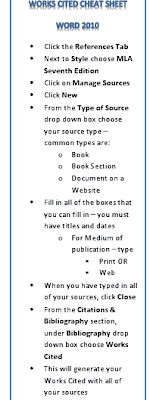 After—I’m not even going to admit the number of years—all the time I’ve been writing works cited pages, I still have to look up the rules and punctuation. It’s an even more difficult task for students—especially young ones. The good news is, in addition to websites like Easybib.com, Microsoft Word 2007 & 2010, will let you create a Works Cited page by typing in the information you have for your sources.
After—I’m not even going to admit the number of years—all the time I’ve been writing works cited pages, I still have to look up the rules and punctuation. It’s an even more difficult task for students—especially young ones. The good news is, in addition to websites like Easybib.com, Microsoft Word 2007 & 2010, will let you create a Works Cited page by typing in the information you have for your sources.
To help my students learn how to use Word to create their Works Cited page, I’ve made a little video, you can check out.
I will also be giving students a “Cheat Sheet” book mark ,and I plan to print, laminate and hang these instructions I made in our computer lab.
Feel free to use and share!
More Works Cited Resources
· “List of MLA 7th Edition ‘Medium of Publication’ Types” - with 4th and 5th graders we keep it to “print” or “web”
· Purdue Online Writing Lab (OWL) - this is one of my favorite resources for the Works Cited page and format. There are tons of handouts and instructions to use!
Comments
Post a Comment